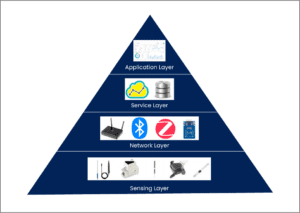- November 29, 2023
- Posted by: Indium
- Category: Industries

Introduction
Have you ever wondered if there will be a day when consumers choose sustainable products or packaging over low-priced goods? Recent research on consumer behavior indicates a growing interest and readiness among consumers to spend extra on products that are produced in an eco-friendly and sustainable manner. With the manufacturing industry leading the global pollution chart, there is an urgent call among world leaders to tackle the carbon footprint. The integration of IoT is a significant accelerating factor in achieving a socially responsible manufacturing environment. From collecting data through its sensors to monitoring the raw material sources, IoT-enabled devices serve as the primary lever in adherence to sustainability, proving the IoT analytics report on IoT-based connections to be around 29 million by 2027.
With the circular economy gaining momentum for its reuse and recycle concept, IoT connections are likely to support manufacturers in the long run, from tracking resource usage to facilitating timely recycling to monitoring waste bin levels for the correct accumulation of waste. It also lets consumers know about the entire history of the material and how to recycle or return products at the end of their lives. This part of IoT is a small application in the whole manufacturing unit.
This blog post navigates you through the intricacies of IoT architecture layers and their significance in advancing sustainable manufacturing. Delve in to recognize the potential roadblocks to integrating IoT-driven connections and devices. Alongside the challenges, we’ve discussed solutions to pave the way for a smooth transition to smart manufacturing with the guidance of Indium Software, which excels at building an agile and resilient business.
Understanding IoT architecture in sustainable manufacturing

The IoT architecture has multiple layers responsible for various functions, each with significance. Let’s explore the four prominent layers and how they assist each department of manufacturing with a sustainable approach.
Perception layer (Sensing layer)
Function: The layer that houses IoT devices like sensors, actuators, and other embedded systems is the primary source for data acquisition. From monitoring waste in the production line to detecting defects in the assembly line to tracking the conditions of materials in the supply chain to supervising asset health and optimizing the logistic route, the significance of the perception layer is unmatched.
Network layer (Transport layer)
Function: Responsible for transmission of data from the sensing layer to the processing unit; this layer embodies communication protocols, gateways, and network infrastructure. Its application is visible in the whole manufacturing sector wherever it senses a deviation or variation; the network layer ensures it carries the data immediately for processing.
Processing layer (Middleware layer)
Function: The layer that processes the data from the network layer for actionable insights comprises servers, storage solutions, and data processing tools. Its application is carried out at all divisions of the manufacturing unit that generate data related to energy, materials, and assets.
Application layer
Function: The layer where actionable tasks are performed with the help of user-end applications and interfaces. The application layer immediately acts on the derived insights by giving alerts or signaling the manufacturer with the detected deviation.
Discover the next step in sustainable manufacturing with Indium Software. Begin your tech transformation now!
The challenges in implementing IoT connectivity
1.Technological integration
Manufacturers in power since the dawn of Industry 1.0 through their antiquated systems and devices find it challenging to come to terms with Industry 4.0, where machine-to-machine communication is functional. The legacy systems that are in operation today were not built for IoT sensors or any other embedded systems, thus having an entirely different interface and architecture from modern devices. This hinders the manufacturing unit from upscaling its sustainable operations, as IoT connections are imperative in achieving an efficient and optimized manufacturing process.
| Challenge | Legacy systems | IoT requirements |
| Communication protocols | Modbus – Designed in 1970, works on the request-reply protocol, where the data model is prefixed with registers and coils. | OPC UA – A platform-independent comprehensive model with a flexible and extensible data model supporting different types of machine-machine interactions |
2. Data overload
Known for their massive data generation, IoT-based devices generate data every second, from sensors on machinery to wearable tech for workers. The data flow is inevitable as its storage, where data needs to be processed and analyzed in real time to gain insights into machine operations, energy consumption, and waste management. For example, if a machine is drawing more power than usual intake, it needs to be rectified immediately, for which data is imperative. Also, storing data helps in historical prediction pattern recognition for machine learning to predict future mishaps if detected. Thus, on the road to sustainability, data plays a major role that must be carefully stored and analyzed for erroneous or half-stored data, leading to wrong decisions.
| Challenge | Early storage solutions | IoT requirements |
| Storage requisite | Punched cards – Physical data storage where access to data is manual and sequential, presenting a slow data process with no real-time analytics. Also, the storage capacity is limited to a dozen bytes of data. | Edge storage – A decentralized computing environment where data storage and processing occur locally near the IoT devices, reducing the need to transfer data to a central server. Designed for rapid access and real-time processing, edge servers range from a few kilobytes on tiny sensors to several terabytes. |
 3. Security concerns:
3. Security concerns:
With the transformative potential for eco-friendly measures, the utilization of IoT devices is welcomed in large numbers. However, lacking robust security features can wreak havoc on the whole manufacturing environment, leading to malware functions or unauthorized access and compromising sustainable goals. As the IoT sensors are sourced from various manufacturers, the security standard imbibed in each differs owing to a potential data breach attack. As data transfers from the edge to the centralized server wirelessly, end-to-end encryption is essential for data to escape from ransomware attacks. Any compromise on the IoT sensors will surely disrupt the manufacturing process, which might not accurately detect mishaps or inefficiencies.
| Challenge | Traditional authentication | IoT requirements |
| Authentication | Token-based – unauthorized access of data and other plants operations were handled by a code generated to verify the user’s identity. It works by focusing on two factors: something the user knows (a password) and something the user has (a token generator device). | Multi-factor authentication – Operates under multiple combinations of passwords, devices, and fingerprints. A robust security mechanism provides a tailored balance between security and user convenience. |
4. Infrastructure and connectivity
For an effective transfer of data and analysis, the IT environment in the manufacturing unit should have high connectivity, for it influences sustainability performance. Imagine a factory operating under solar energy for its operations in a remote location. IoT sensors are essential to monitor the solar panel’s efficiency and streamline its energy distribution to record the necessary parameters that support optimizing solar operations. What if the sensor fails to monitor the ambiance temperature panel health or other necessary criteria? The whole manufacturing process will halt, disturbing the entire cycle. Thus, a high connectivity infrastructure that supports IoT-based devices with an uninterrupted data flow and processing supply is a challenging requirement.
| Challenge | Remote location | IoT requirements |
| Connectivity | Wired connectivity – Based on terrestrial infrastructure such as cables, routers, and switches, offers low latency during high voluminous data. Also, the disruption to physical parts is likely high, making it expensive. | Satellite connections – Ideal for remote locations where higher latency is achieved through geostationary satellites. Rapid deployment and higher bandwidth make it an ideal connectivity for IoT-based devices. |
Bridging the IoT gap: Practical solutions for modern challenges
Pilot projects: A prior feasibility study on a sustainable approach in the manufacturing unit will assist in ascertaining specific areas where sustainable measures can be implemented, and the result generated can be recorded for further enhancement. Thus, a phased approach allows companies to refine their sustainability initiatives regarding cost, performance, and benefit.
Bosch’s integration of IoT in its production line is the best example of phased implementation, where it started a pilot project that utilized IoT for real-time analysis of machine performance to reduce unplanned downtime. Thus, the IoT-based sensors assisted the company in predictive maintenance that monitored the machinery for an advanced maintenance schedule to cut down on unexpected service charges and disruptions to production. The integration of IoT further improved Bosch’s sustainability goals by supervising energy optimization. The company further developed an IoT suite for other companies to assist them in improving their operational efficiency.
Training and skill development: Investing in curricula programs or collaborative partnerships with academic institutions assists manufacturers in learning new technologies or tools that are a significant add-on toward their sustainability goals. They can invite industry experts to the manufacturing facility to conduct workshops and other programs that serve as a two-way opportunity. Besides organizing workshops, continuous in-house training for employees and certification programs can be conducted to foster their innovation in upskilling sustainability practices that adhere well to breakthrough technologies.
Events like “The Greener Manufacturing Show and Plastic Waste Free World Europe” are excellent examples of international conferences that welcome industry experts from various industries and locations. Citing its two previous edition successes, Mike Robinson, CEO of Trans-Global Events, shared his anticipation for the forthcoming event, saying, “We are thrilled to announce the return of The Greener Manufacturing Show and Plastic Waste Free Europe in 2023. As we progress, we aim to develop an even more vibrant platform that promotes dialogue, highlights innovative solutions, and catalyzes meaningful change.” The show is expected to be an incredible opportunity where like-minded individuals share their insights, trends, and updates on the circular economy, recycling practices in the manufacturing sector, and other latest trends.
Robust data management: The importance of data and its role in sustainable measures cannot be overstated, as they are the driving force of IoT-based devices. Data collected from various sensors for analysis and readability assists in energy optimization, performance streamlining, material management, and other efficient alternatives. Thus implying the significance of the data governance framework for a data-driven sustainable manufacturing unit.
General Electric shines brightly with its manufacturing facility, recognizing the importance of IoT connectivity. The company collected data from its manufacturing unit’s production line, assembly line, and environmental factors through IoT sensors that assisted in optimizing its gas production and distribution processes. This helped them save 10% of gas consumption and $70 million annually.
Partnering with IoT vendors: Collaboration with the experts offers the manufacturers tailored solutions that address their needs directly, helping them tightly adhere to their sustainable goals. Harnessing practical methodologies related to IoT-connected devices is easy and effective for implementation and integration with various departments of the manufacturing sector. Directly dealing with IoT-based vendors fosters rigid energy, material, asset, and logistics management planning.
Audi’s partnership with Cisco showcased the power of IoT in manufacturing, as the company witnessed resilient and scalable production. Audi developed the Edge Cloud for Production (EC4P) platform, which aims to virtualize production assets to manage and optimize its production assets, leading to more efficient and sustainable manufacturing processes.
IoT’s role in driving sustainability in manufacturing
Energy efficiency: As a primary application, IoT devices are significant in real-time monitoring and assist manufacturers with alerts for spikes in voltage or more energy consumption. It also helps regulate the power of equipment based on its performance. For example, the IoT device automatically sets to low-power mode if the machine is idle, contributing to a greener environment.
Predictive maintenance: The unplanned downtime is reduced significantly with the utilization of IoT-based connections, which specialize in predictive maintenance. Continuous monitoring of assets’ health provides a comprehensive view for future analysis. Incorporating advanced algorithms helps analyze the data from sensors, historical data, and other patterns to predict the repair in advance, thereby optimizing resource allocation and enhancing safety measures.
Supply chain optimization: The disruption from sourcing to delivery is combated with IoT sensors that help track inventory management levels and optimize logistics routes. A visible approach in the supply chain is mandatory in the manufacturing unit to avoid last-minute delays in stocks, energy, or other deviations. Blockchain technology integration and IoT devices provide a tamper-proof record of every transaction and movement in the supply chain, ensuring product transparency, trust, and authenticity.
Water management: The integral part of the manufacturing unit needs meticulous attention in allocating and utilizing water; low availability will halt the entire production process. IoT deployment is successful as it detects water usage in real-time, ranging from quality to any production or assembly line leakage. It is also believed that IoT-based water meters are accurate in measuring water consumption, assisting manufacturers with monthly bills. The sensors can track wastewater management’s final destination, preventing penalties and other environmental harm.
Harness IoT solutions with Indium Software’s expertise
Partner with Indium Software for a strategic transformation encompassing the seamless integration of IoT connections and sensors. The diverse team of seasoned professionals at Indium Software is dedicated to transforming your manufacturing facility into a data-centric powerhouse, underpinning the shift toward sustainable manufacturing. With their deep domain knowledge, the experts craft innovative solutions, ensuring optimal utilization of technology. Step forward into the era of Industry 4.0 and intelligent manufacturing, promising increased revenue, augmented productivity, refined resource management, and amplified operational efficiency.
Conclusion
Adopting agile solutions through IoT-based devices proves to be an imperative and innovative factor for manufacturing sectors whose main concern is sustainability. From optimizing energy efficiency to waste reduction to streamlining operations, the manufacturing industry can reap amazing benefits that add value to the business and help focus the company towards an environmentally friendly landscape. Furthermore, as technology continues to evolve, the synergy between IoT and other emerging technologies, such as blockchain and artificial intelligence, will further amplify the benefits, driving innovation, transparency, and sustainability in manufacturing operations. Thus, IoT is a transformative tool bridging the gap between traditional manufacturing practices and the future’s sustainable, efficient, and responsive manufacturing processes. Start your sustainable evolution with Indium Software, which designs tech solutions aligned with your business’s long-term vision.







